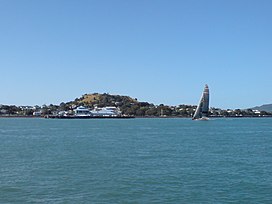Auckland Mount Victoria
Takarunga / Mount Victoria is the highest volcano on Auckland's North Shore, rising to 66 metres in elevation.
Its age is currently unknown. Its lava flows now line much of Devonport's waterfront. Takarunga was the location of an important pā used by Tāmaki Māori peoples. In the late 19th century, a gun fort was built on top of the hill, in order to defend the city of Auckland. As a designated tūpuna maunga, the mountain has been governed by the Tūpuna Maunga Authority, along with thirteen other cones throughout Auckland, since 2014.
| Takarunga | |
|---|---|
| Mount Victoria | |
 Takarunga / Mount Victoria as seen from the south on the Waitematā Harbour, the Devonport ferry terminal in the middle distance. | |
| Highest point | |
| Elevation | 66 m (217 ft) |
| Coordinates | 36°49′36″S 174°47′56″E / 36.8266°S 174.7990°E |
| Geography | |
| Location | North Island, New Zealand |
| Geology | |
| Volcanic arc/belt | Auckland volcanic field |
Geography
The hill provides panoramic views of Auckland's Waitematā Harbour and the inner Hauraki Gulf. Over the years the peak and upper slopes have housed a signal station for shipping, artillery emplacements, farmland, and various concrete army bunkers, some from as early as the 1870s. One bunker now serves as the venue for the Devonport Folk Music Club.
The slopes of Takarunga / Mount Victoria are also home to Devonport Primary School, Takarunga Playcentre, a tennis court, a cemetery, a water reservoir which maintains supply to the area, and a scenic lookout. The old Signalman's House is now home to the Michael King Writers Centre which provides writers-in-residence programmes, hosting for visiting writers, residential workshops for experienced writers, and a series of workshops for young poets and emerging writers. The writer-in-residence programmes are supported by Creative New Zealand and the University of Auckland.
History
An important pā once occupied its slopes; some of its earthworks can still be seen. In the 18th century, Takarunga was seasonally occupied by Waiohua paramount chief Kiwi Tāmaki, during the seasons for bird catching and preservation. The traditional name, Takarunga, literally means "The Hill Standing Above", and contrasts with Mount Cambria, a now-quarried hill known by the name Takararo, or "The Hill Standing Below". A scoria mound known as Duders Hill, on Takarunga / Mount Victoria's southern slopes was mostly quarried away. French navigator Jules Dumont d'Urville climbed the hill in 1827, and it was given the name Mount Victoria, referring to Queen Victoria, by early settlers.

In 1841 a signal station was constructed on the peak, to better facilitate traffic to the Port of Auckland, and in 1880 the hill became a public reserve. In 1885, a gun fort was constructed on the peak, which was in use until after World War II.
Treaty settlement
In the 2014 Treaty of Waitangi settlement between the Crown and the Ngā Mana Whenua o Tāmaki Makaurau collective of 13 Auckland iwi and hapu (also known as the Tāmaki Collective), ownership of the 14 Tūpuna Maunga of Tāmaki Makaurau / Auckland, was vested to the collective, including the volcano officially named Takarunga / Mount Victoria. The legislation specified that the land be held in trust "for the common benefit of Ngā Mana Whenua o Tāmaki Makaurau and the other people of Auckland". The Tūpuna Maunga o Tāmaki Makaurau Authority or Tūpuna Maunga Authority (TMA) is the co-governance organisation established to administer the 14 Tūpuna Maunga. Auckland Council manages the Tūpuna Maunga under the direction of the TMA.
Gallery
- The north side of Takarunga / Mount Victoria, seen from Lake Road
- The Bunker, home of the Devonport Folk Club
- BL 8 inch Mk VII Disappearing gun at the summit of Takarunga / Mount Victoria
- 'Mushrooms' on top of the hill, which are in fact vents for a water pumping station
References
- Volcanoes of Auckland: A Field Guide. Hayward, B.W.; Auckland University Press, 2019, 335 pp. ISBN 0-582-71784-1.
Further reading
- Bruce W. Hayward, Graeme Murdoch and Gordon Maitland (2011). Volcanoes of Auckland: The Essential guide. Auckland University Press, Auckland. ISBN 9781869404796.
- Ewen Cameron, Bruce Hayward and Graeme Murdoch (1997). A Field Guide to Auckland: Exploring the Region's Natural and Historic Heritage. Godwit Publishing Ltd, Auckland. ISBN 1-86962-014-3.
- Lloyd Homer, Phil Moore and Les Kermode (2000). Lava and Strata: A guide to the volcanoes and rock formations of Auckland. Landscape Publications Ltd, Wellington in association with the Institute of Geological and Nuclear Sciences, Lower Hutt. ISBN 0-908800-02-9.
- Ernest J. Searle, revised by Ronald D. Mayhill (1981). City of Volcanoes: A geology of Auckland. Longman Paul Ltd, Auckland. ISBN 0-582-71784-1.
External links
- Michael King Writers' Centre
- Devonport Folk Music Club
 Media related to Mount Victoria, Auckland at Wiki Commons
Media related to Mount Victoria, Auckland at Wiki Commons- Photographs of Mount Victoria held in Auckland Libraries' heritage collections.
This article uses material from the Wikipedia English article Mount Victoria (Auckland), which is released under the Creative Commons Attribution-ShareAlike 3.0 license ("CC BY-SA 3.0"); additional terms may apply (view authors). Content is available under CC BY-SA 4.0 unless otherwise noted. Images, videos and audio are available under their respective licenses.
®Wikipedia is a registered trademark of the Wiki Foundation, Inc. Wiki English (DUHOCTRUNGQUOC.VN) is an independent company and has no affiliation with Wiki Foundation.




